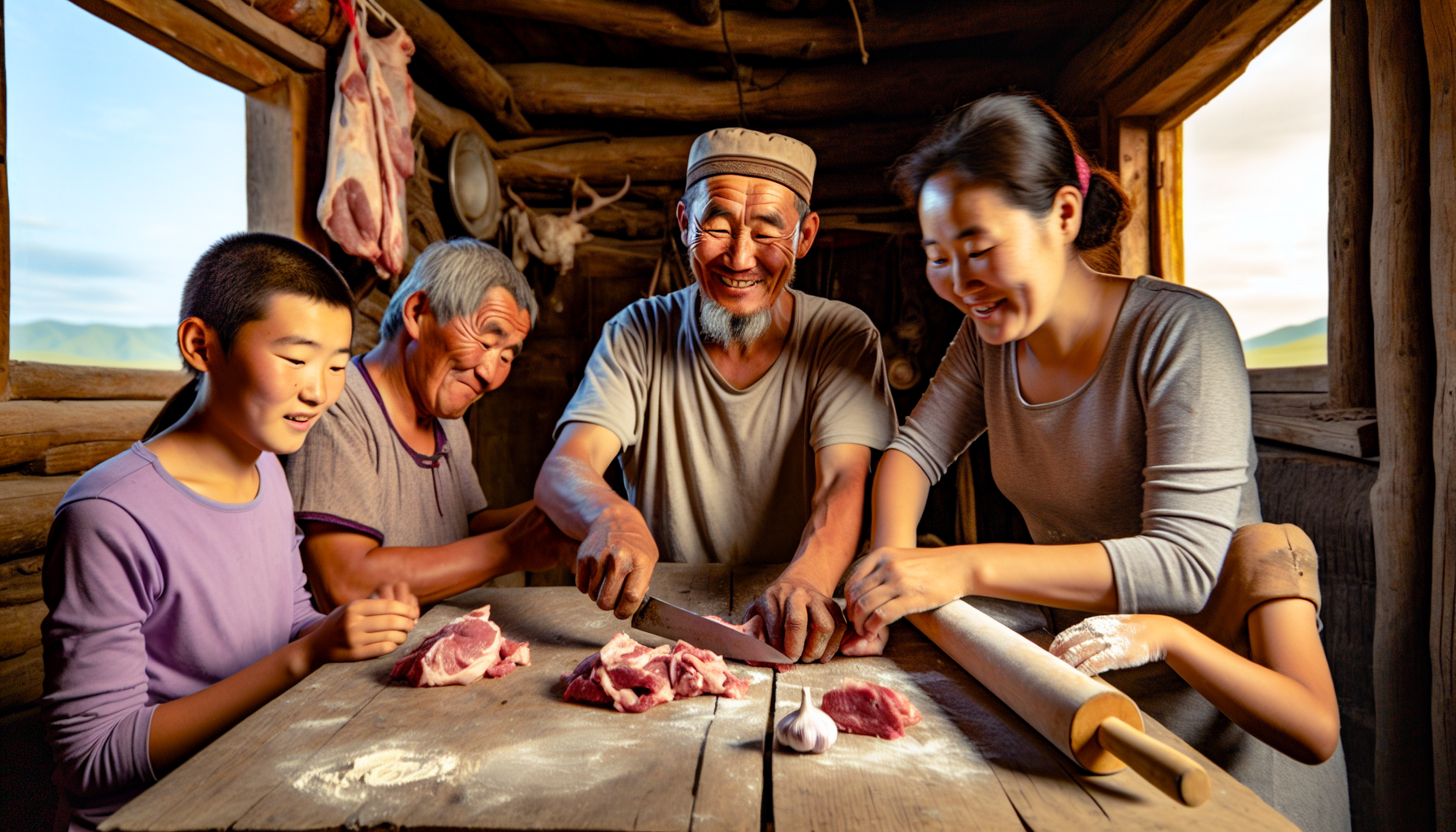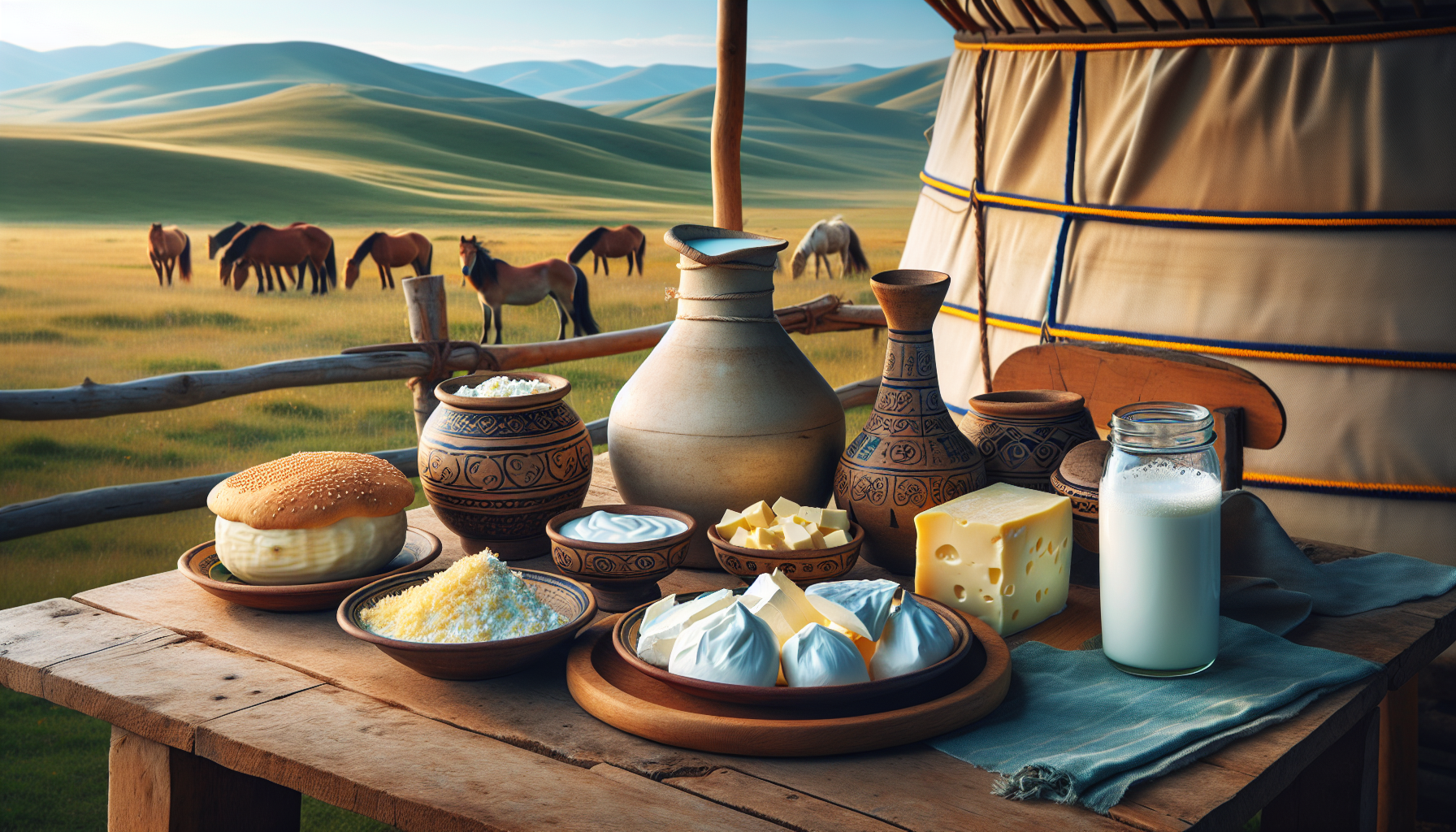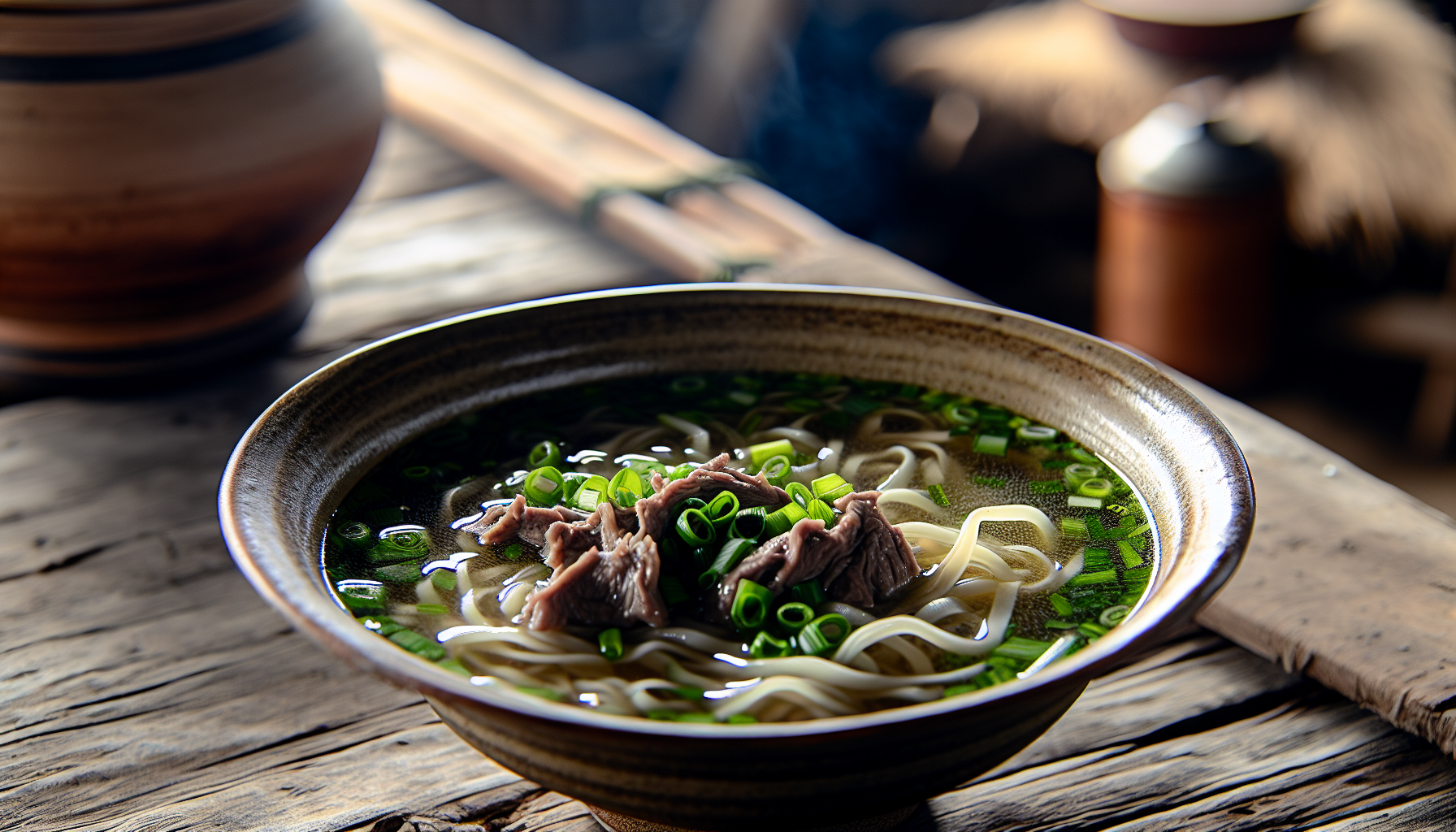Mongolian Food
Contact us for travel suggestions
Savor the Steppe: A Tasty Guide to Traditional Mongolian Food
Looking to unravel the essence of Mongolian food? It’s a culinary ride shaped by the rugged steppe, with the likes of meat and dairy featuring prominently, steeped in millennia of nomadic traditions. This article will take you through the culinary staples of Mongolia, showcasing how a simple array of ingredients lays the groundwork for dishes that are rich in both flavor and history, without getting lost in unnecessary details. Explore Mongolia on a self drive tour with AVIS and visit the best Mongolian restaurants, stay with nomadic families, camel herders and eagle hunters to taste each of their food.
Key Takeaways
- Mongolian cuisine is rooted in its nomadic heritage, relying heavily on meat, dairy, and preserving techniques like air-dried meats (bort) to cope with the harsh winters.
- Unique cooking methods like hot stone-cooked dishes (Khorkhog) and the Boodog technique, where meat is cooked inside an animal carcass, showcase the distinctive traditions of Mongolian food culture.
- Despite globalization and the advent of fast food, traditional Mongolian foods remain a strong and evolving part of Mongolia’s cultural identity, underscoring the importance of adaptation while maintaining culinary heritage.
Exploring the Nomadic Diet: Meat, Dairy, and the Mongolian Way

Mongolian cuisine’s uniqueness stems from its distinctive nomadic diet. Meat, dairy, and animal fat form the cornerstone of traditional Mongolian food, with horse meat being a particular favorite, especially during the harsh winter months. Why? It’s rich in protein, iron, and vitamins, making it a vital source of nutrition to combat the cold.
The Mongolian diet is significantly influenced by animal husbandry. Living in harmony with the vast steppe, nomadic Mongolians have mastered the art of raising and using animals for sustenance. This lifestyle puts meat and dairy products at the heart of many Mongolian meals, from simple boiled meat dishes to the celebrated Mongolian barbecue.
The Role of Animal Husbandry
Animal husbandry, a fundamental aspect of Mongolian culture, provides the meat and dairy that form the backbone of numerous Mongolian dishes. The reliance on animal fat in Mongolian cuisine is not merely a matter of taste but a survival strategy, helping Mongolians withstand the biting cold winters and demanding physical work.
In Mongolia, horse meat dishes like Aduuni Chaasan Mah (horse meat simmered in salt water) and Kaz (salted and smoked horse meat sausage) are immensely popular. Borts, a type of Mongolian jerky made with beef, goat, or camel meat, also holds a special place in the cuisine. Originally a vital asset for Mongolian soldiers in the era of Genghis Khan, Borts continues to add flavor and sustenance to dishes like Tsuivan and Banshtai Tsai.
Dairy Delights from the Steppe

In addition to meat, Mongolian cuisine also prominently features a variety of dairy products. Cheese, yogurt, and fermented mare’s milk are integral components of the diet, reflecting the richness of the steppe and the nomadic tradition.
Whether it’s the buttery layer of Urum, made from boiled unpasteurized milk, or the doughy Orom, made from a flour mixture, Mongolian clotted creams are enjoyed with jam, sugar, or bread. Cheese holds a special place too, with soft cheese like Byaslag and dried milk curds like Aaruul and Aarts featuring prominently.
And let’s not forget the thick and sour Mongolian yogurt, often sweetened with sugar or paired with dishes like Urumtei Budaa, a delightful concoction of rice and clotted cream.
The Art of Preserving: Dried Meats and Winter Provisions

The art of preserving is key to enduring Mongolia’s lengthy, freezing winters. Dried meat, or bort, is a classic winter food in Mongolian cuisine, prepared from air-dried goat, camel, or cow meat. This form of preservation allows the meat to be stored without refrigeration throughout the year, making it a reliable source of nutrition in the colder months.
Drying meat in Mongolia is a particularly intriguing process. The meat is sliced into long strips and hung under the roof of a yurt to dry. The circulating air gradually dehydrates the meat over a month, transforming it into hard sticks with a brown color.
This dried meat, when combined with the nation’s love for dairy, results in an array of heartwarming winter dishes that are as nourishing as they are delicious.
Heart of the Hearth: Traditional Cooking Techniques
Unique cooking techniques, along with distinctive ingredients, define Mongolian cuisine. The use of hot stones in the cooking process, for instance, is a distinctive feature of traditional Mongolian food. These stones are heated and used to prepare dishes like Khorkhog, making the meat extraordinarily tender and tasty.
Another intriguing cooking method is the Boodog technique, usually reserved for special occasions. Here, goat meat is cooked inside a goat or marmot using hot stones. This not only serves as a natural cooking vessel but also imparts a unique flavor and texture to the dish, making it an unforgettable culinary experience.
The Magic of Hot Stones
In Mongolian cuisine, hot stones aren’t merely tools for cooking; they also enhance flavor. Used in traditional dishes like Khorkhog, these stones add a smoky depth to the food, making the meat and veggies uniquely delicious.
Heating the stones is a process in itself. They are placed over a fire until they attain the right temperature. Once hot enough, they are added to the meat in a container to cook everything evenly. However, while indulging in this unique cooking method, always remember to stay safe. Using gloves or tongs to handle the hot stones and ensuring good ventilation while cooking are crucial.
Boodog: The Ultimate in Natural Cooking Vessels
Boodog, celebrated in Mongolian culture, is a unique cooking technique that transforms an animal’s carcass into a natural cooking container. This cooking technique dates back to the Mongolian nomadic warriors who traveled light and used the animal carcass as cookware, typically using lamb or goat.
Preparing Boodog is an art. The steps involved are:
- Season the meat and place it back into the carcass.
- Add vegetables, hot stones, and water to the carcass.
- Scorch the carcass to remove the fur.
- Cook the dish until hot fat drips out, indicating that it is ready to be served.
This cooking method not only serves up a feast but also strengthens the bond among people who prepare and share the Boodog, making it a memorable part of Mongolian food culture.
A Feast of Flavors: Popular Mongolian Dishes
With a variety of dishes to suit diverse tastes, Mongolian cuisine offers a veritable banquet of flavors. From meat-filled dumplings to deep-fried pastries, each dish tells a story of Mongolia’s rich culinary heritage. Take the Buuz dumplings, for instance. These are not just food; they are a celebration of life, eaten during the Mongolian Lunar New Year (Tsagaan Sar) and helping people survive the harsh winters.
Another popular dish is Khuushuur, a deep-fried meat-filled pastry that is as flavorful as it is filling. Whether it’s the hearty fillings or the crispy golden-brown exterior, each bite of Khuushuur is an exploration of Mongolian cuisine’s heart and soul.
Buuz: The Celebratory Dumpling
Buuz dumplings hold an iconic status in Mongolia’s culinary world. More than just a dish, they represent the nation’s love for meat and the enduring tradition of gathering together for a hearty meal. Filled with a mix of lamb, tail fat, and seasonings like onions and caraway, these dumplings are a testament to the heartiness of Mongolian cuisine.
Despite their rich and hearty filling, Buuz dumplings are more than just a treat for the taste buds. They are a symbol of celebration, commonly consumed during festivities and special occasions. Whether savored with a mutton and fat broth or enjoyed as they are, Buuz dumplings capture the essence of Mongolian cuisine in every bite.
Khuushuur: Deep Fried Delight
For those who enjoy deep-fried treats, Khuushuur is a must-try. These deep-fried pastries are filled with mutton or beef, seasoned with onions and spices, and are a big part of the Mongolian diet.
Khuushuur isn’t just a dish; it’s a celebration. It’s the main dish served during Naadam, a major Mongolian festival that highlights traditional sports like wrestling, horse racing, and archery.
Whether you’re munching on one during a festival or enjoying one as a snack on a regular day, Khuushuur promises a burst of flavor that is quintessentially Mongolian.
Nourishing Soups and Stews: Comfort Foods of Mongolia

Beyond meat and dairy, comforting soups and stews constitute a significant portion of Mongolian cuisine. A staple among these is Guriltai Shul, a straightforward meat broth made by boiling mutton and adding in handmade wheat-flour noodles. Onions or spring onions are occasionally thrown in, and the broth is often beefed up with added sheep’s tail fat.
In addition to Guriltai Shul, there are other popular variations like the Banshtai shul, a dumpling soup, and tasalan guriltai shul, a simply seasoned soup using boiled meat bones and hand-cut noodles. These soups and stews provide warmth and sustenance, especially during the harsh winters, making them a comforting part of Mongolian cuisine.
Guriltai Shul: The Noodle Soup Staple
Guriltai Shul is the soup that epitomizes Mongolian cuisine. This nourishing noodle soup is a staple in Mongolian households and is often enjoyed after a long day of tending to animals or exploring the countryside.
Packed with mutton or beef, Guriltai Shul is a hearty soup that is as nutritious as it is delicious. It boasts about:
- 440 calories
- 43g of carbs
- 31g of protein
- 16g of fat
Making it a comforting bowl of goodness that is typical of Mongolian cuisine.
The Richness of Meat and Vegetable Soup
In addition to the hearty meat-based soups, Mongolian cuisine also features a variety of meat soup options, including both meat and vegetable soups. Some popular combinations include:
- Beef and potato soup
- Mutton and carrot soup
- Goat and turnip soup
- Camel and onion soup
These soups offer a delightful balance of flavors and are a staple in Mongolian cuisine.
These soups not only offer a hearty meal but also pack a nutritional punch. They provide essential nutrients like:
- protein
- iron
- zinc
- a host of vitamins and minerals
making them not just tasty but also very good for you.
The Bread Basket: From Fried Dough to Pancakes
Bread and its variants occupy a special position in Mongolian cuisine. From fried dough to pancakes, they are enjoyed in various forms and are a testament to the culinary creativity of the Mongolians. Some popular types of Mongolian bread include:
- Boortsog: a type of deep-fried bread made from flour, water, yeast, butter, salt, and sugar. It’s cut into smaller pieces and then deep-fried until golden and delicious.
- Bansh: a steamed dumpling made from flour and water, often filled with meat or vegetables.
- Guriltai shul: a noodle soup made with handmade noodles, meat, and vegetables.
- Tsuivan: a dish made with stir-fried noodles, meat, and vegetables.
These bread dishes, being widely eaten dishes in Mongolian cuisine, are enjoyed by locals and visitors alike.
Another popular bread product is Gambir, a deep-fried dough cookie enjoyed throughout the day or served during visits to nomads’ homes. These bread products, while seemingly simple, reflect the adaptability and resourcefulness of the Mongolian people, making the most of the ingredients available to them.
Beverages of the Steppe: Fermented Drinks to Salty Tea

Accompanying the hearty dishes, Mongolian beverages range from fermented drinks to salty tea, providing a refreshing contrast. Airag, made from fermented mare’s milk, is a traditional beverage often consumed during celebrations and festivals. With a strong, sour, fermented taste, it is an acquired taste that is deeply ingrained in Mongolian culture.
In addition to Airag, salty milk tea, known as süütei tsai, is a staple beverage in Mongolian households. Made with:
- water
- brick tea
- milk
- salt
- sometimes sheep tail fat
It captures the essence of Mongolian hospitality and is a comforting drink to enjoy on a cold day.
Airag: The Traditional National Beverage
Airag, Mongolia’s national beverage, is a distinctive drink crafted from fermented mare’s milk. This traditional beverage is not just a drink but a symbol of Mongolian hospitality and tradition. It’s enjoyed during celebrations like the Naadam festival, weddings, and the New Year, making it a significant part of the Mongolian culture.
Making Airag, a traditional fermented mare’s milk, is an elaborate process involving filtering fresh mare’s milk through a cloth, pouring it into a leather sack (Khukhuur), and then stirring the milk with a wooden masher. Despite its strong, sour taste, it’s a beloved beverage that is said to make you feel strong and happy, offering health benefits like boosting endurance and improving gut health.
The Warming Sip of Salty Milk Tea
Another well-liked beverage in Mongolia is süütei tsai, or salty milk tea. This comforting drink is a daily tradition that keeps the home vibes alive for Mongolians. Made by boiling tea in water and then adding an equal amount of milk to the mixture, it’s a warm and comforting drink that’s enjoyed throughout the day.
In addition to its comforting taste, süütei tsai is known to have health benefits. It’s believed to aid digestion and have a positive impact on dental health, making it a delightful combination of taste and wellness.
Culinary Crossroads: Influences from Central Asia and Beyond
As a crossroads between Central Asia and beyond, Mongolian cuisine absorbs influences from various cultures, becoming a culinary melting pot. Drawing from:
- Persian
- Indian
- Arab
- Turkish
- Chinese
- African
- Russian culinary traditions
- Other Central Asian countries
Mongolian cuisine, a unique blend of flavors, is best represented by its diverse mongolian foods.
The impact of the Silk Road on Mongolian cuisine cannot be overstated. It brought in ingredients like:
- almonds
- apricots
- pistachios
- rice
It also introduced cooking styles from China, Russia, and other Central Asian places that have greatly influenced how Mongolian food has developed.
The Gobi Desert's Influence on Mongolian Cuisine
Mongolian cuisine has been profoundly influenced by the Gobi Desert, with its harsh climate and sparse vegetation. It has influenced the nomadic lifestyle, animal husbandry practices, and consequently, the food culture. Limited resources led to the adaptation of traditional dishes, and now staple foods like Bortzig, a hard unleavened bread, and Buhel Mahan Zoog, a meat-based dish, are common for breakfast.
Despite the challenging conditions, the people of the Gobi desert have shown remarkable adaptability in their food habits. They often use cooking methods like boiling, curdling, and cooking with hot stones, which not only help conserve resources but also work well with their nomadic lifestyle.
The Modern Mongolian Plate: Adapting Tradition
As globalization spreads its influence worldwide, Mongolian cuisine has also undergone a transformation. The influence of global cuisine and better connectivity has led to the creation of fusion dishes that mix traditional Mongolian elements with flavors and techniques from other cuisines.
Fast food chains like KFC have made their way into Mongolia, changing the eating habits of the people. However, despite these changes, traditional Mongolian food continues to hold its ground, adapting and evolving while still keeping its roots intact.
Summary
Embarking on this culinary journey through Mongolia, we’ve explored the unique flavors and techniques that make Mongolian cuisine such a delight. From the hearty meat and dairy products to the comforting soups and stews, traditional Mongolian food is a reflection of its nomadic lifestyle and the resilience of its people.
As we conclude our journey, let’s remember that Mongolian cuisine is more than just its ingredients and cooking techniques. It’s the spirit of the Mongolian people, their traditions, and their passion for good food that truly define this unique cuisine. So, the next time you have a chance to savor a Mongolian dish, remember the rich history and culture that it carries within.
Frequently Asked Questions
What is traditional Mongolian food?
Traditional Mongolian food includes a variety of meats such as mutton, beef, camel, horse, and even marmot, often accompanied by vegetables, noodles, rice, and pasta. Sheep and goat meat are commonly eaten, with less consumption of beef, camel, pork, and horse meat.
Is Mongolian food similar to Chinese?
No, Mongolian food is different from Chinese cuisine. Both may use similar ingredients, but each has its own distinct dishes and cooking techniques.
What does Mongolian food taste like?
Mongolian food is known for being heavy and meat-centric, with a reliance on mutton, milk products, and dough. The flavors tend to be fairly mild due to the limited use of spices and sauces.
What are some popular Mongolian dishes?
Mongolian dishes like Buuz, Khuushuur, Guriltai Shul, and Boodog are popular choices, offering a variety of flavors and cooking styles. Try these dishes to experience the unique flavors of Mongolian cuisine!
What is the traditional Mongolian cooking method called?
The traditional Mongolian cooking method is called Boodog, and it involves cooking meat inside a goat or marmot using hot stones. Enjoy experimenting with this unique cooking method!
 Mongolian dumpling
Mongolian dumpling